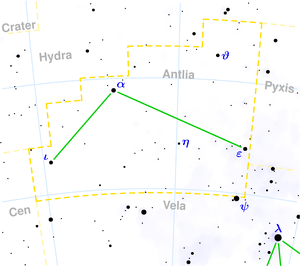.
Antlia
Antlia ( Latin: pump, from Ancient Greek: ἀντλία - antlia, "bilge-water, filth") is a relatively new constellation as it was only created in the 18th century, being too faint to be acknowledged by the ancient Greeks. The IAU adopted it as one of the 88 modern constellations. Beginning at the north, Antlia is surrounded by the sea snake Hydra, the compass Pyxis, the sails (Vela) of the mythological ship Argo and finally the centaur Centaurus.
Notable features
Antlia is a faint constellation void of bright stars. The brightest star is α Antliae, a magnitude 4.25m orange giant.
Notable deep sky objects
* NGC 2997: Spiral galaxy of type Sc which is inclined 45° to our line of sight.
* NGC 3132: Planetary nebula, also called Eight-burst Nebula or Southern Ring Nebula. At its heart is a binary star system.
* Antlia Dwarf: This 14.8m dwarf spheroidal galaxy belongs to our Local Group of galaxies. It was only discovered as recently as 1997.[1]
History
The French astronomer Abbé Nicolas Louis de Lacaille created 14 constellations for the southern sky to fill some star-poor regions, among them Antlia. It was originally denominated Antlia pneumatica and commemorated the air pump invented by the French physicist Denis Papin.[2]
There is no mythology attached to Antlia as Lacaille discontinued the tradition of giving names from mythology to constellations and instead chose mostly names of instruments used in science.
Citations
1. ^ APOD: April 23, 1997 - Antlia: A New Galactic Neighbor
2. ^ Star Tales. Antlia. Retrieved on 2007-12-3.
References
* Ian Ridpath and Wil Tirion (2007). Stars and Planets Guide, Collins, London. ISBN 978-0007251209. Princeton University Press, Princeton. ISBN 978-0691135564.
Links
|
The 88 modern constellations
Andromeda | Antlia | Apus | Aquarius | Aquila | Ara | Aries | Auriga | Boötes | Caelum | Camelopardalis | Cancer | Canes Venatici | Canis Major | Canis Minor | Capricornus | Carina | Cassiopeia | Centaurus | Cepheus | Cetus | Chamaeleon | Circinus | Columba | Coma Berenices | Corona Australis | Corona Borealis | Corvus | Crater | Crux | Cygnus | Delphinus | Dorado | Draco | Equuleus | Eridanus | Fornax | Gemini | Grus | Hercules | Horologium | Hydra | Hydrus | Indus | Lacerta | Leo | Leo Minor | Lepus | Libra | Lupus | Lynx | Lyra | Mensa | Microscopium | Monoceros | Musca | Norma | Octans | Ophiuchus | Orion | Pavo | Pegasus | Perseus | Phoenix | Pictor | Pisces | Piscis Austrinus | Puppis | Pyxis | Reticulum | Sagitta | Sagittarius | Scorpius | Sculptor | Scutum | Serpens | Sextans | Taurus | Telescopium | Triangulum | Triangulum Australe | Tucana | Ursa Major | Ursa Minor | Vela | Virgo | Volans | Vulpecula |
Retrieved from "http://en.wikipedia.org/"
All text is available under the terms of the GNU Free Documentation License


